
The story seemed harmless enough at first. “Imagine, if you will, a one-of-a-kind retreat,” Jerry Romano wrote, detailing a water feature his New Jersey-based Liquid Designz team built. “Huge boulders form breathtaking waterfalls and rushing streams. A pristine body of water emulates a serene, natural mountain spring. Arched water spouts grace the exterior, and a flat boulder serves as a table with crystal clear water bubbling up through a hole in the center. It is a refreshing and safe bathing experience that must be seen to be believed … a truly one-of-a-kind, functioning pond ecosystem that also [serves] as a recreational pool.”
Oh, the drama in that last sentence.
When POND Trade published Romano’s story in its May/June 2013 issue, reader feedback was immediate and incendiary. Critics called and emailed to voice their concerns. Internet forums ignited as biology experts and pond professionals argued about pathogens and electrical circuits.
Some touted installations like the one Romano described — often referred to as “swim ponds” — as a safe and natural way to interact with beloved water features. Others condemned them as hazardous bacterial breeding grounds. Still others called the entire idea a Pandora’s Box of legal and political issues that threatened to destroy the pond industry as we know it.While the arguments were as diverse as their authors, one thing was clear: swim ponds have sparked perhaps the most heated and contentious debate in the history of ponding.
But who’s right? As is always the case in this industry, a serious search for answers begins with a long, hard look at the water.
## Swimming with the Enemy ##
In May of 2012, 24-year-old college student Aimee Copeland was whizzing across a Georgia river on a homemade zip line when the cable snapped, sending her careening into the rocks below. The fall carved a giant gash in her leg that required 22 staples to close. Cheerful and optimistic, Aimee assured her parents that her injury was nothing to worry about.Her parents’ concern was justified, however, when Aimee’s leg began to disintegrate before their very eyes. Three days after her accident, she lost consciousness and was put on life support. By the time she regained the ability to breathe without assistance 17 days later, both of her feet and hands and much of both forearms had been amputated. Doctors say she was lucky to escape the incident with her life.
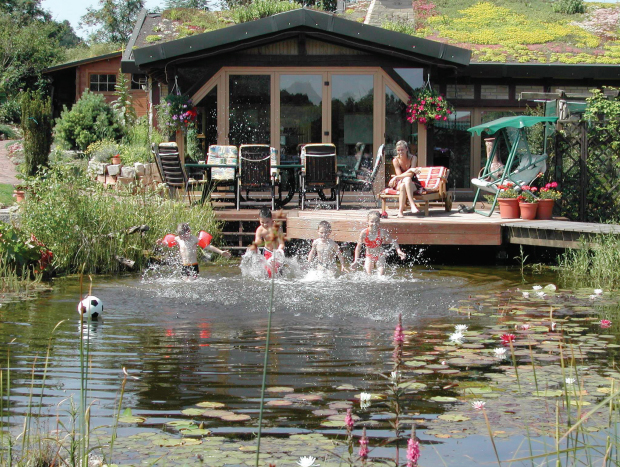
Tests revealed that Aimee suffered necrotizing fasciitis, a rare but fast-spreading skin infection in which bacteria literally eats away a patient’s flesh. The infection can stem from contact with many different strains of bacteria, but Aimee’s was caused by Aeromonas hydrophila — a bacterium found primarily in the fresh or brackish water of warm climates, such as rivers (like the one Aimee fell into), lakes … and potentially, man-made ponds.
“There have been many instances of flesh-eating bacteria and parasites causing damage that came from people going swimming in freshwater lakes as well as swim ponds,” said Max Taylor, owner and operator of Texas-based Magnolia Ponds & Water Gardens. “Warm water is a haven for both good and pathological bacteria. Swim ponds are a closed system; the possibility of ear infections and the ingestion of bacteria that has the potential for severe damage is greatly increased.”
Meyer Jordan agrees. The owner of Ripples Inc. in Pensacola, Fla., Jordan has 15 years of experience in the design, construction and maintenance of life-supporting water features. He is also a self-proclaimed research junkie with an emphasis on microbiology and how it applies to aquatic habitats.
“The world is more polluted than most people realize or are willing to accept,” Jordan said. “The EPA recently stated that 90 percent of all inland bodies of water, including streams, were polluted. Taking into account the ubiquitous nature of many aquatic pathogens, no swimming venue, constructed or natural, can be considered absolutely safe for human immersion. Levels have been established that, if observed, reduce the risk of infection for the general public to an acceptable level. These levels, however, can only be maintained through a proven mode of disinfection. At present, as relates to constructed, closed-system swim facilities, the only accepted effective modes of disinfection are the use of chlorine, UV and/or ozone. Others do exist but are not practical for use in swim venues.”
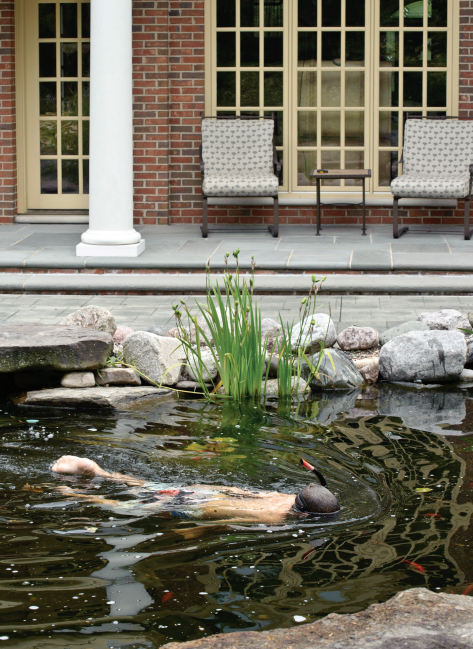
According to Jordan, there are a plethora of pathogens (infectious agents such as harmful bacteria, protozoa and other microorganisms) that can lurk in a non-chemically treated pond. However, he claims that some, such as Giardia and Cryptosporidium, are more troublesome than others. “Both are more tolerant of disinfecting treatments than the other pathogens,” he said. “So vigilance is a must in any swimming venue.”
Jordan isn’t the only one who thinks swim ponds pose a high risk of infection. “There are super streptococcus bacteria out there that are immune to antibiotic treatments,” said David Jones, owner of The Pond Professional in Georgia. Jones is also the executive director and chairman of the board of the International Professional Pond Companies Association (IPPCA).
“They’re potentially lethal. E. coli bacteria, on a warm summer day, triples its colony every hour. These things harbor and multiply in these water features.”
Jordan suspects that many cases of infection are misdiagnosed because the onset of symptoms can take anywhere from a few hours to two or three weeks. “It would be very understandable for one who develops symptoms after a couple of weeks to blame it on Taco Bell or some other source, when the true source is the swimming venue,” he said.
“I have absolutely no concern over the [bacteria] side of it, because our ponds are healthier than a normal, stagnant pond you might encounter in the woods,” said Fred Pape, specialty projects manager at Aquascape Inc. in St. Charles, Ill. “The system uses a naturally balanced ecosystem approach … you’re coming up with a pond system that is based on what Mother Nature does to clean her water systems. We can’t do better than that. We think we can with chlorination and UV and all those other things. But if you’re mimicking what Mother Nature does, it really doesn’t get any better than that. I personally don’t have any issue with [swimming in a swim pond], and have no problem with my kids swimming in it.”
Pape is not the only pond professional who feels this way. Raymond Campbell of Lost Eden Ponds in Clearwater, Minn. says his company has built over a dozen “eco-balanced ponds for birds and wildlife … that people can swim in.” Campbell asserts that the key to a pond that’s safe for swimming is in the materials.
“Rock, plants, bacteria, bottom aeration, circulation with filtration and fish,” Campbell said. “These are the necessary ingredients for an eco-balanced pond, when used properly. Anyone who has mastered the eco-balanced pond can build a swimming pond.
“We never use any ‘-cide’ of any kind, nor do we use UV sterilizers or any other electronic doodads,” Campbell explained. “We use an intake bog at the pump or pump intake line, and an up-flow bog at the other end of the plumbing. One- to three-inch river rock is applied at three to five inches deep and acts as the medium for beneficial bacteria to colonize. The bottom aerator keeps this beneficial bacteria alive and healthy. Healthy bacteria colonies will keep the pond bottom clean and the water clear. You will never see suspended algae in a pond built this way.”
As for the pathogens, Campbell says those are easily managed.
“Pathogens are a health concern in any body of water that is used for swimming. Lakes have little streams from farm fields and often drainage from adjoining neighborhoods running into them. Our swim- ming ponds are constructed with a heavily planted dry stream utilizing 1.5-inch river rock at a depth of five inches. This helps to clear the water of lawn debris and other possible contaminants prior to reaching the pond. After a hard rain the water may get a bit tan and the new introduction of nutrients may result in an algae bloom, but the ingredients needed for E. coli and similar are not present.”
## A Shocking Possibility ##
According to critics, swim ponds present another danger that has nothing to do with bacteria: risk of electric shock.
“I come from the swimming pool industry and am familiar with the electrical codes and access/exit requirements,” Taylor said. “Most pond builders do not have a clue what the National Electrical Code requires for pools, especially the bonding and grounding of the basin, pumps, lighting. For instance, the pond lights we all use are not approved. There is no submersible pump that is UL approved for use in any vessel which is used for swimming or wading. They are not grounded. Using a GFIC (ground fault interrupter circuit) is not grounding a pump. Period.”
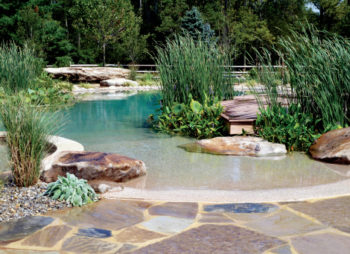
Jones agrees.
“Literally none of the pond industry equipment is rated for swimming pool stuff,” he said. “Electricity and water should really be an influencing factor in a design. There are some people who claim their pond equipment is UL rated, but when you get down to the UL rating, it’s not for human contact.
“There was another outfit [that was] using a 12-volt submersible pump,” Jones continued. “I know a lot of people with high-dollar koi fish who won’t even put 12-volt lighting in their pond. The biggest risk, even with low voltage, is that usually you’ve run a copper wire into the water for your voltage. And if by some accident, you were to get a lightning strike, it could possibly follow that copper wire into the pond.”
## What’s in a Name? ##
Some pond professionals assert that as long as the pond is built and maintained properly, the difference between a decorative pond and a pond fit for swimming is little more than semantics.
“Anything we build that we know people are going to swim in, we refer to as a recreational pond rather than a swim pond,” Pape said. “We always sort of put a disclaimer that this is not approved by certain aspects as a swimming pond, although we [Aquascape employees] all swim in all of our ponds all the time. It’s one of those things where we’re totally comfortable in it, but legally we probably shouldn’t say that it’s a swim pond because we do use submersible pumps and such that aren’t rated for swimming pool applications.”
“I am neither an attorney nor a politician,” Campbell said, “but I do know from experience that when approaching the city for permits, wordage used can be an important factor. We don’t build swimming ponds! We build highly artistic and naturalistic, eco-balanced ponds for birds and wildlife … that people can swim in. Our wording can play a great role in the issues that we may or may not face.”
Not everyone sees the name distinction that way, however.
“Changing the name to something other than ‘swim’ pond does not alleviate our culpability as professionals in the realm of true customer safety,” Taylor said. “When a customer asks us to build something, knowing the associated problems, code violations and lack of proper liability coverage, changing the name to remove the word ‘swim’ to make a buck is shady at best. If we are in fact professionals, shouldn’t we be more concerned about the safety and well-being of the consumer than we are about being able to have a swim pond feather in our cap or a check in the bank?”
As the preeminent executive at the IPPCA, Jones is particularly adamant about this point. In fact, the only official statement the IPPCA ever released addressed this issue specifically, declaring that any body of water built with the “intention or anticipation of human immersion” was not a pond at all, but rather a pool — and should therefore be subject to the codes inherent in that distinction.
“To me, in the ideal world, swim and pond don’t go together,” Jones said. “Swimming pools is a whole different industry than ponds. If you’re going to promote these things, you’re adhering to U.S. national building codes on pools. They would have to be a swimming pool.”
Taylor agrees.
“Swim ponds fall under codes for swimming pools,” he said. “Call them what you want, they are vessels for which people will be immersed and will be required to meet the swimming pool codes.”
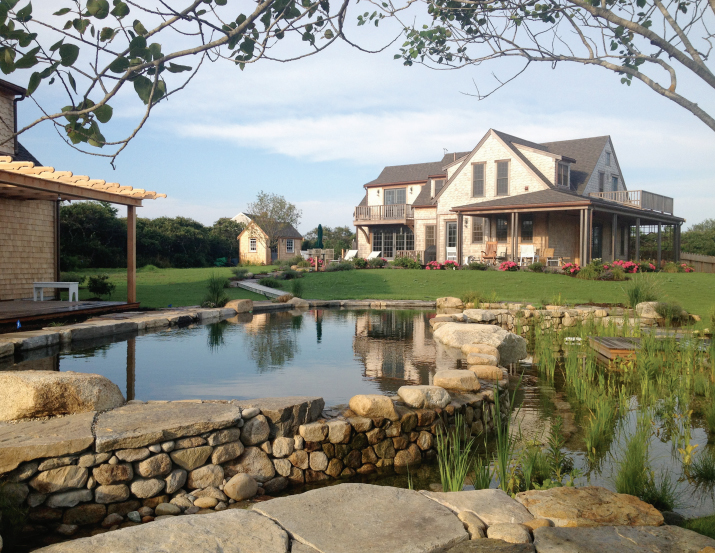
## Natural Swimming Pools ##
To Alan Weene and his colleagues, that small distinction holds a world of importance. Weene is the head of marketing and technical support at the North American branch of BioNova® Natural Pools.
According to the company’s website, BioNova® is “a global network of land- scape professionals, contractors, and pool builders who work synergistically to promote the state-of-the-art of Natural Swimming Pool (NSP) design, construction, aesthetics and maintenance.” Weene said that the New Jersey-based company and its global partners — there are 94 of them in 44 countries — have constructed hundreds of residential and commercial NSPs around the world and are actively building a number of them in residential settings across the U.S.
“We don’t call them swimming ponds because they’re not ponds,” Weene said of the BioNova NSPs. “They are swimming pools, and therefore they are permitted as such, and therefore they are also subject to all of the codes and regulations for safety and accessibility.”
## Pool Codes: a Formidable Obstacle ##
According to Weene, BioNova has not encountered prohibitively specific codes governing residential pools in North America that would prevent them from building NSPs.
“When we’re approaching a municipality, we’re telling them that we’re building a swimming pool. From what we’ve encountered, they don’t really care how you’re treating the water, whether it’s with chemicals or otherwise. An alternative sanitation system using UV or ozone … a natural swimming pool is neither of those things. By definition, a natural swimming pool is not sterile or disinfected in any way. But that doesn’t really matter to the municipality from a residential standpoint.
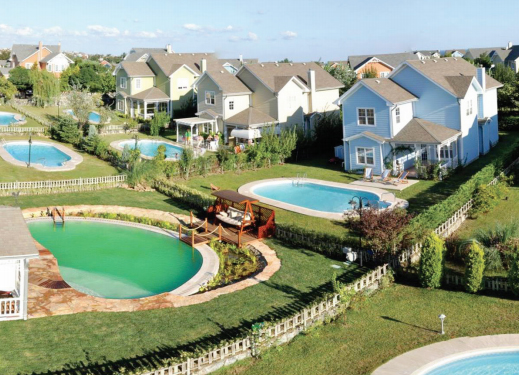
In the residential sphere, there really isn’t any regulation or local jurisdiction that dictates how a swimming pool can be treated, as long as it’s for private use on your own personal property.”
Commercial pools, however, are a different animal. Most states impose formidable standards of mechanical and chemical function on commercial pools that few conventional ponds could meet.
In the state where POND Trade is located, for instance, the General Assembly’s Illinois Administrative Code lists detailed requirements for protective enclosure walls, self-closing gates and bather load (the minimum amount of water surface area required per bather). It dictates the allowable slope of the pool floor, the radius of junctions between walls and the placement of depth markers. It requires the presence of a four-foot deck surrounding the pool and dictates the materials with which the deck may be covered. It requires a certain number of ladders, steps and ramps and specifies their dimensions. It even mandates the installation of a drinking fountain. These are but a few of the explicit specifications listed in Section 820.200 of the code — and that’s without mentioning the extensive rules regarding electricity and chemical water treatment, which critics say are some of the most pressing points against swim ponds.
Perhaps due to this exhaustive legislation, until recently there was zero precedent for public natural pools on this continent. But that changed in August of this year, when BioNova began building the first commercial, public natural swimming pool in North America. Crews are currently working on the massive project at Webber Park in Minneapolis.
“[The pool will be] 100% chemical-free using BioNova proprietary biological filtration technology,” Weene said of the groundbreaking installation. “It is going to be over 21,000 square feet of swimming area with an additional 16,000 square feet of planted regeneration zone and will support over 1,000 bathers per day.”
But how did BioNova crack the code, so to speak, and gain municipal approval for a non-sterile public pool? Like Illinois, Minnesota has extensive and specific laws governing public pools. Some sections of the Minnesota Administrative Rules even appear to prohibit non-chemically disinfected pools. Section 4717.1750 Subpart 3, for instance, sets guidelines for water condition with regards to chlorine or other chemicals.
“When in use, a pool must be continuously disinfected with a chemical that imparts an easily measured, free available residual,” the rules read. (The Minnesota Administrative Rules can be found on the website of Minnesota’s Office of the Revisor of Statutes.)
According to Weene, BioNova meets or exceeds the legislative standards imposed upon swimming pools simply by adhering to German FLL guidelines — which, he claims, are as much as twice as stringent as U.S. EPA guide- lines. Over 20,000 NSPs have been installed in Europe, he says, providing plenty of opportunities for study.
“Once you get to the commercial sector, there are very strict regulations in terms of bather health and safety [and] microbiological content,” Weene said. “What we had to do for the city of Minneapolis was work hand-in-hand with the municipal health department as well as the department of parks and recreation to provide them with the empirical evidence … the observed data from many years of research at public natural swimming pool installations in Europe, showing that the treatment of the water using purely biological processes is capable of providing water that is safe and healthy for bathing. Specifically, citing analysis reports where the microbiological bacterial indicator limits were never reached or exceeded over the complete season of use in these swimming pools.
“That was really a very challenging hurdle to get over,” Weene continued. “However, BioNova — specifically our [president and CEO], James Robyn — is the only person in North America who’s qualified to have that kind of a conversation with a municipality or a health department, in terms of working on getting new legislation drafted for one of these public natural swimming pools to be permitted.”
BioNova is no stranger to overcoming hurdles; the company holds the only U.S. and Canada patent for the biological filtration of swimming pool water — a system invented by BioNova founder Gerhard Brandlmaier. While patent number 7,332,082 is publicly available on the website of the U.S. Patent Office, it falls far short of providing a recipe for recreating BioNova’s proprietary system.
“Our patent is the hydraulics; the proprietary equipment, and the controlled, directed flow through our biological fine filters, the planted regeneration zone, and recirculation of that water between the regeneration zone, mechanical equipment and the swimming area,” Weene explained. “All of our natural swimming pool installations adhere to that patent.”
Whatever the specifics of the system may be, the results were enough to satisfy the city of Minneapolis. The grand opening of the pool is scheduled for August 2014.
## A High-Profile Test Case ##
Not everyone considers the matter settled, however — particularly pond professionals.
“This project will be the test case for NSPs,” Meyer Jordan said of the Webber Park pool. “I am afraid that there will be an incident. No way to tell the magnitude of the incident. I am really amazed that, considering all of the scientific data against such an operation, it was even approved. Surely, the health professionals were asked to weigh in. BioNova has been fighting for years to get established in the U.S. and this is definitely a make-or-break project for them and NSPs in general.
“Let me clarify one thing,” he added. “I am not declaring that all NSPs are unsafe. It is that I have yet to see any scientific proof offered by BioNova … to prove that they are safe.”
## If Legislation could Kill ##
To some, a third potential impact of the swim pond trend is the most concern- ing of all: unnecessary, crippling legislation of non-swim ponds. If swim ponds continue to gain popularity, the same kind of rules that regulate pools could be brought to bear on all pond installations … with catastrophic results.
“The more we push the envelope, the more exposure we have to call in the governing bodies for increased regulation,” Taylor said. “If [swim ponds] are not built according to swimming pool codes, then they will bring more and more scrutiny into our midst.”
Jones agreed.
“Basically, you’re going to end up with ponds that aren’t going to be over 12 inches deep,” he said. “They’re going to have to be qualified as ‘wading pools.’ We don’t need that kind of crap shoved down our throats building ponds.”
Most frightening of all is Pape’s doomsday scenario.
“I’m sure they — they being whatever governmental agency — will over-regulate it and probably force us to use external pumps,” he said. “Probably right down to some sort of chlorination treatment which will totally defeat the purpose of a pond.”
## Professional Responsibility ##
While the debate over swim ponds and natural swimming pools continues to rage with no decisive end in sight, nearly everyone involved agrees on one thing: the serious need for common sense and professional responsibility throughout the industry.
“Ultimately it’s the installer that the liability is coming down on,” Pape said. “So if there’s any risk or chance of a problem, you have to err on the side of caution.”
Jones says that regardless of one’s personal views on swimming in ponds, a professional must put the safety of the customer first.
“There’s a big difference between doing something for yourself as a homeowner and doing it as a professional for pay,” he said. “I’ve gone swimming in lakes and ponds myself as a kid growing up. I’ve got a picture of my son snorkeling, playing peek- a-boo with the koi in our front pond just before his seventh birthday. But this was my son, on my property, in my pond, in my yard.
“Professionally speaking,” he added, “if Aimee Copeland had been [zip lining] in her parents’ newly constructed swim pond, don’t you think they would be suing that contractor for everything he’s got? As a serious professional, I’ve got no business subjecting people to health risks when I know what the possible risks are. You’ve got to weigh the cons as well as the pros. In my opinion, a responsible professional would say, ‘Thanks, but no thanks. I’m not doing that.’”
Time will tell if Jones’ opinion becomes the law. In the mean- time, swim ponds and natural swimming pools still occupy a unique legal middle ground. Their future — and that of our industry — has yet to be decided. Until then, the responsibility for professional and ethical building practices rests heavily on the shoulders of our readers.



“Some pond professionals assert that as long as the pond is built and maintained properly, the difference between a decorative pond and a pond fit for swimming is little more than semantics.”
This highlights the naivety of pond “professionals”. They are not actually measuring biological cleanliness or activity; they are simply guessing because the water looks clean. You do not have to be a Biologist to understand this difference, but it probably should be required to design swimming ponds. The ponds we design for swimming all have significant additional elements that are not necessary in fish ponds.
I agree with your comments, as with Pools by Nature poolsbynature.net operation system is complete method, which includes among others, pool and fitting configuration, water flow management, filtration and bio equipment layout.
Did anyone else notice that those for it are in Northern States while those opposed are in Southern states?
Also I have no appreciation for being referred to as an uncaring crook only interested in collecting money from soon to be sick or dead clients. Lousy editing and I’m still irritated all these years later.
If a client asks me to build them a stream that flows up hill I will tell them that’s beyond my abilities. I don’t tell them it can’t be done. And if I lived in Louisiana I wouldn’t build swimming ponds. Some “experts” step a little too far out of their expertise to the point of deflamation.
Note from the publisher:
This is a controversial subject, thus the headline “Pond or Pool: The fierce and divisive swim pond debate”.
The author interviewed both sides, and what was said by each side appeared in the article and was not censored.
Your comments were not being called out by anyone, for the comment you did not like was another person’s opinion, and was not based on your comments. They did not even see your contribution to the article until after it was published.
Your point about northern states versus southern states is well taken. We welcome comments!